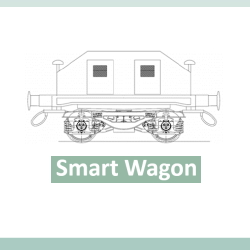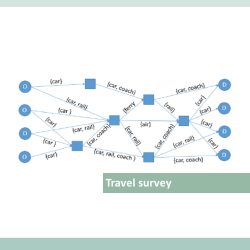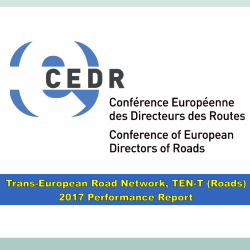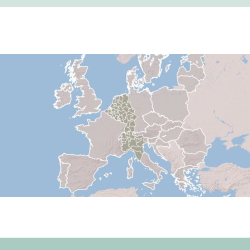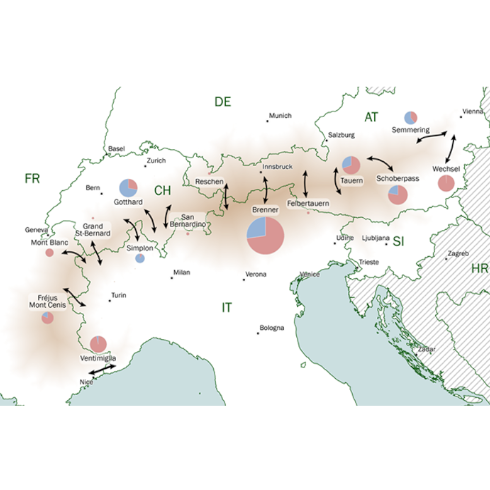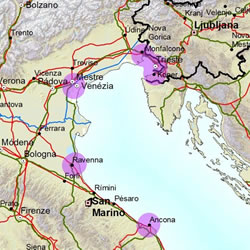- All
- African projects
- assessment
- assessment selected projects
- Assessment selected projects 2
- Assessment selected projects 3
- Assessment selected projects 4
- ASTRA
- Cost Benefit Analysis
- Electric mobility and ITS
- MOMOS
- planning
- planning selected projects
- planning selected projects 2
- planning selected projects 3
- planning selected projects 4
- planning selected projects 5
- projects
- Railways projects
- research
- research selected projects
- research selected projects 2
- research selected projects 3
- studies
- studies selected projects 1
- studies selected projects 2
- studies selected projects 3
- studies selected projects 4
- studies selected projects 5
- TRTingegneria
- TRUST
- urban mobility
- Automatic Rail Freight Transport System – Analysis of Transport Costs The study developed the feasibility analysis of an innovative and automatic rail freight transport system and elaborated a business plan to assess its economic and financial sustainability. The aim of introducing automatic vehicles for rail freight transport is that of enhancing the internal efficiency of the production system (e.g., in intermodal terminals and logistic centres), by reducing the operating costs and vehicles manoeuvring. Also, the use of automatic vehicles allows to optimise the shipment of cargos from intermodal terminals and logistic centres to transport networks to which they are connected. Further to this, the advantage of using automatic vehicles is twofold. First, automatic vehicles support higher safety levels of the operations avoiding internal collisions (i.e., vehicle-to-vehicle communication and knowledge of the relative position). Second, they reduce the environmental impact, optimising manoeuvring and needs of energy and fuel. The analysis developed an estimation of the operating costs of three scenarios, considering rail-road intermodal transport of semi-trailers, and compared them against the “as-is” situation as follows: wagon towed by a manoeuvring bogie equipped with a traditional coupling system; automatic manoeuvring wagon equipped with a traditional coupling system; automatic manoeuvring wagon equipped with an automatic coupling system. The estimation of the costs shows that there exists a competitive advantage for transporting by rail. With respect to road transport, the difference of cost of transporting by rail increases for longer trips and if a higher level of automation is introduced. The most important advantage of the Smart Wagon system, compared to conventional transport systems, can be obtained when specific conditions hold, namely in contexts such that the demand of freight transport is weak and spread. For example, within ports characterized by a multiplicity of connected internal terminals, the Smart Wagon system would allow to develop transport solutions that merge the demand generated in each internal terminal and share the final destination. Some aspects deserve consideration before implementing an automatic manoeuvring wagon system. First, the cost of feeder legs, which is often a critical cost component for choosing intermodal transport (i.e., the magnitude of the cost is proportional to the length of the trip). Second, with respect to transporting only via road, one should take into account the longer time of the trip, due to two modal shifts (i.e., road-rail and viceversa) and additional waiting times before the train run.
- EU survey on issues related to transport and mobility Nowadays, a reliable analysis of the transport system which allow to monitor the achievement of goals set by the European policy require the availability of updated mobility data. In line with this concept, in 2013 (and again in 2018) the European Commission launched a study involving the design of a questionnaire for a survey that investigate the mobility habits of people at European level. The survey involves 1000 individuals for each of the 28 European countries. In addition to traditional socio-demographic data and daily mobility habits, the survey deeply investigates: the role of long distance trips by mode and by purpose; the tendency to make multimodal trips; the awareness of the opportunities offered by mobile applications and innovative ICT solutions. These studies, both coordinated by TRT and implemented by IPSOS, follow the same methodological approach. This guarantees continuity in data collection allowing for data comparability, definition of trends and monitoring the impact of transport policies.
- Odometer tampering – measures to prevent it (Research for TRAN Committee) The study, commissioned by the TRAN Committee of the EU Parliament, examined the phenomenon of odometer tampering in the EU and proposed concrete actions to tackle it. Despite the EU legislation has addressed the issue in the “Roadworthiness Package”, a major gap has been identified in the long timeframe occurring between the vehicle’s registration and the first Periodical Technical Inspection, as well as the lack of sufficient cooperation and data exchange on odometer readings between EU Member States (MS). The implementation of a EU-wide data exchange system between EU MS on odometer readings could help competent authorities to detect fraudsters (as shown by the Slovakian and the Dutch bilateral cooperation, making use of the EUCARIS platform). The study also explored the best practices developed in Belgium and the Netherlands, where the problem was nearly eradicated in the last years. In both countries the percentage of unauthorised manipulations dropped below 1%. Furthermore, the study highlighted that odometers are still inadequately protected against cybersecurity threats. Potential IT solutions to combat the phenomenon have been suggested. [tw_button icon=”” link=”https://www.trt.it/archivio-progetti/” size=”small” rounded=”false” style=”flat” hover=”default” color=”#223468″ target=”_self”]Projects[/tw_button]
- CEDR’s TEN-T (Roads) 2017 Performance Report The 2017 TEN-T (Roads) Performance report is the fifth biannual report issued by the Conference of European Directors of Roads (CEDR) on the performance of the TEN-T road network within the participating countries. Biennial CEDR reports offer a coherent set of data with which to monitor trends and identify changes in the performance of the TEN-T road network since the year 2009. As such, these reports are a particularly useful source of information for individual National Road Authorities, regulatory bodies and others for benchmarking purposes and for setting national performance targets. More specifically, the CEDR reporting framework is based on a common simple Location Referencing Model and a consistent set of performance indicators based on common data definitions and on data provided directly by National Road Administrations. A web map is developed to display the GIS layer of CEDR’s logical network, in conformity with CEDR’s Location Referencing Model, and to allow for the visualisation of thematic maps showing road performance indicators at link level (e.g. road type, number of lanes, etc.) and for different years. An online tool is developed for the collection and visualization of CEDR Strategic Key Performance Indicators. For more information, please check the project website – cedr.eu
- Transport Market Study: Quantification of modal shift potential on the Rail Freight Corridor Rhine-Alpine The study, coordinated by TRT and involving relevant partners across Europe, aimed to quantify the potential modal shift to rail thanks to the improvement in transport performance on the Rail Freight Corridor Rhine-Alpine. More specifically, the objective of the study was to investigate the possibility to introduce: heavier and longer trains, faster trains (less stops), more reliable trains. The work was structured by three consecutive activities: analysis of the freight transport demand, quantification of the cost savings in relation to heavier, faster and more reliable trains, quantification of modal shift potential. For more information The Transport Market Study summary report is available for download here
- Transalpine Observatory – Data collection and analysis of freight flows across the Alps The objective of the Observatory is to collect and make available the information for the EU-CH Terrestrial Transport Committee implementing and managing the Agreement on Terrestrial Transport between the European Union and Switzerland on 21 June 1999. As a part of the Consortium, TRT has collected, verified and analysed data on road, rail and combined transport activities through the Alps for Italian side. The types of collected data involved information on traffic, infrastructure, vehicles, transported goods, market operators, costs and environmental impacts. All data have been compared for the period 2020-2023 regarding the borders with France, Switzerland and Austria. One of the main interest of the project has been the evaluation in time of the modal split across the Alps useful for the reduction of transport’s environmental impact. TRT has also worked on designing and updating the cost model on road and combined transport, Unaccompanied (UCT) Accompanied (ACT) and Motorway Of the Sea (MoS), adoptable also for other spatial contests.
- Adriatic Gateway – Development of the Northern Adriatic port cluster The main objective of the project was to develop the Adriatic Gateway integrating the Northern Adriatic Port Cluster in order to meet the upcoming requirements for the fundamental role that the Adriatic Corridor should play in the European transportation network. The project was structured in three phases: traffic and market studies providing an overall picture of present and future transport demand and supply in Europe, definition of a model of excellence for a multi-port gateway. The Adriatic Gateway Model, intended as a multi-port, designing whether and how the pre-identified “excellent” models can be applied to the specific case of the AG and more generally the Mediterranean Area.
- TRACECA IDEA I – Transport dialogue and interoperability between the EU and its neighbouring countries and central Asian countries Funded by the Directorate General for Cooperation and Development of the European Commission within the framework of the TRACECA Programme (TRAnsport Corridor Europe Caucasus Asia), the IDEA project aimed at improving the functioning of the transport corridor connecting Europe with Central Asia. The beneficiary countries of the TRACECA programme are Georgia, Armenia, Azerbaijan, Ukraine, Moldova, Kazakhstan, Tajikistan, Uzbekistan, Kyrgyzstan, Turkmenistan, with Romania, Bulgaria and Turkey as observatory countries. The project activities included the construction of the regional transport model, the deployment of a capacity building program for the national officers on themes like project planning and assessment, the definition of indicators to measure the corridor attractiveness and the organization of two international conference where the countries representatives presented their transport project along the corridors to banks and international financial institutions. The consortium led by TRT was composed of PTV, Dornier Consulting and Alfen.
- Mobility data in European countries As part of a study aimed at modelling the charging infrastructure for electric vehicles in Europe, Nissan Technical Centre Europe charged TRT to carry out two studies. The first study was aimed at elaborating a set of statistical indicators to describe commuting car trips with destination in a selected number of European cities. The indicators was developed for all cities with a population of more than 250,000 inhabitants in seven different countries: France, Germany, Italy, Netherlands, Norway, Spain and UK. The objective of the second study was to identify the location of fast recharge facilities available in the same seven countries mentioned above and also to provide typical traffic daily profiles on the road network of these countries.

